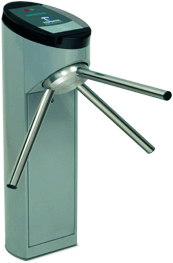|
Event-driven Finite-state Machine
In computation, a finite-state machine (FSM) is event driven if the transition from one state to another is triggered by an event or a message. This is in contrast to the parsing-theory origins of the term finite-state machine where the machine is described as consuming characters or tokens. Often these machines are implemented as threads or processes communicating with one another as part of a larger application. For example, a telecommunication protocol is most of the time implemented as an event-driven finite-state machine. Example in C This code describes the state machine for a very basic car radio system. It is basically an infinite loop that reads incoming events. The state machine is only 2 states: radio mode, or CD mode. The event is either a mode change from radio to cd back and forth, or a go to next (next preset for radio or next track for CD). /********************************************************************/ #include /************************************** ... [...More Info...] [...Related Items...] OR: [Wikipedia] [Google] [Baidu] |
Computation
Computation is any type of arithmetic or non-arithmetic calculation that follows a well-defined model (e.g., an algorithm). Mechanical or electronic devices (or, historically, people) that perform computations are known as '' computers''. An especially well-known discipline of the study of computation is computer science. Physical process of Computation Computation can be seen as a purely physical process occurring inside a closed physical system called a computer. Examples of such physical systems are digital computers, mechanical computers, quantum computers, DNA computers, molecular computers, microfluidics-based computers, analog computers, and wetware computers. This point of view has been adopted by the physics of computation, a branch of theoretical physics, as well as the field of natural computing. An even more radical point of view, pancomputationalism (inaudible word), is the postulate of digital physics that argues that the evolution of the universe is itself ... [...More Info...] [...Related Items...] OR: [Wikipedia] [Google] [Baidu] |
Finite-state Machine
A finite-state machine (FSM) or finite-state automaton (FSA, plural: ''automata''), finite automaton, or simply a state machine, is a mathematical model of computation. It is an abstract machine that can be in exactly one of a finite number of '' states'' at any given time. The FSM can change from one state to another in response to some inputs; the change from one state to another is called a ''transition''. An FSM is defined by a list of its states, its initial state, and the inputs that trigger each transition. Finite-state machines are of two types— deterministic finite-state machines and non-deterministic finite-state machines. A deterministic finite-state machine can be constructed equivalent to any non-deterministic one. The behavior of state machines can be observed in many devices in modern society that perform a predetermined sequence of actions depending on a sequence of events with which they are presented. Simple examples are vending machines, which dispens ... [...More Info...] [...Related Items...] OR: [Wikipedia] [Google] [Baidu] |
Semiring
In abstract algebra, a semiring is an algebraic structure similar to a ring, but without the requirement that each element must have an additive inverse. The term rig is also used occasionally—this originated as a joke, suggesting that rigs are ri''n''gs without ''n''egative elements, similar to using '' rng'' to mean a r''i''ng without a multiplicative ''i''dentity. Tropical semirings are an active area of research, linking algebraic varieties with piecewise linear structures. Definition A semiring is a set R equipped with two binary operations \,+\, and \,\cdot,\, called addition and multiplication, such that:Lothaire (2005) p.211Sakarovitch (2009) pp.27–28 * (R, +) is a commutative monoid with identity element 0: ** (a + b) + c = a + (b + c) ** 0 + a = a = a + 0 ** a + b = b + a * (R, \,\cdot\,) is a monoid with identity element 1: ** (a \cdot b) \cdot c = a \cdot (b \cdot c) ** 1 \cdot a = a = a \cdot 1 * Multiplication left and right distributes over addition ... [...More Info...] [...Related Items...] OR: [Wikipedia] [Google] [Baidu] |
Finite-state Machine
A finite-state machine (FSM) or finite-state automaton (FSA, plural: ''automata''), finite automaton, or simply a state machine, is a mathematical model of computation. It is an abstract machine that can be in exactly one of a finite number of '' states'' at any given time. The FSM can change from one state to another in response to some inputs; the change from one state to another is called a ''transition''. An FSM is defined by a list of its states, its initial state, and the inputs that trigger each transition. Finite-state machines are of two types— deterministic finite-state machines and non-deterministic finite-state machines. A deterministic finite-state machine can be constructed equivalent to any non-deterministic one. The behavior of state machines can be observed in many devices in modern society that perform a predetermined sequence of actions depending on a sequence of events with which they are presented. Simple examples are vending machines, which dispens ... [...More Info...] [...Related Items...] OR: [Wikipedia] [Google] [Baidu] |
Specification And Description Language
Specification and Description Language (SDL) is a specification language targeted at the unambiguous specification and description of the behaviour of reactive and distributed systems. Overview The ITU-T has defined SDL in Recommendations Z.100 to Z.106. SDL originally focused on telecommunication systems; its current areas of application include process control and real-time applications in general. Due to its nature it can be used to represent simulation systems without ambiguity and with a graphical notation. The Specification and Description Language provides both a graphical ''Graphic Representation'' (SDL/GR) as well as a textual ''Phrase Representation'' (SDL/PR), which are both equivalent representations of the same underlying semantics. Models are usually shown in the graphical SDL/GR form, and SDL/PR is mainly used for exchanging models between tools. A system is specified as a set of interconnected abstract machines which are extensions of finite state machines (FSM) ... [...More Info...] [...Related Items...] OR: [Wikipedia] [Google] [Baidu] |
